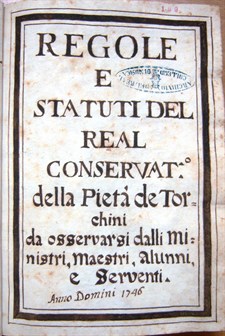Conservatorio della Pietà dei Turchini

In 1573, in the small church dell’Incoronatella, in rua Catalana, now Via Medina, several residents of the area met in order to form a brotherhood that, after a devastating famine, in 1583 built a shelter that could collect and host abandoned or missing children. At the beginning the orphans were taken into the church dell’Incoronatella, but growing their number, they were subsequently translocated in a building behind the church that today takes the name della Pietà dei Turchini, on Via Medina. The children were dressed as clerics with the “skirt”, the “cloak” and the “cap” of blue color (turchino). They acquired the official name of Confraternity of Santa Maria della Pietà , because of the veneration of the statue of Santa Maria della Pietà , and the name of Turchini because of the colour of their clothes. It is the only of the four Neapolitan orphanages that from the first moment presents itself solidly organized and maintains a rigorous economic management over the years and a disciplinary regime, deserving in a short time the protection of King Philip III of Spain. This event gave the incentive to bequests and purchases by the noble class of the city. Great emphasis was given not only to the teaching, but also to the human condition and psychological state of children, so as to register the smallest number of defections by the younger guests, while the percentage of spontaneous priestly vocations was high. The lessons were designed according to a careful and balanced weekly calendar. The organization of the school was very precise, as can be seen from the extraordinary description handed down to us by the “Rules and statutes of the Real Conservatorio della Pietà dei Turchini, that have to be observed by ministers, teachers, students and servants”, written specially for the good management of the institution. With the development of melodrama it reached the full maturation of the Conservatory, with the blossoming of fervent talents (Francesco Provenzale, Nicola Fago, Leonardo Leo) that highlight the heyday of the institution, but also mark the beginning of a new era centered on the theater and the consequent change of behaviour. Among the Masters of the Chapel of the Conservatorio della Pietà dei Turchini we remind: Gennaro Ursino, Nicola Sala, Giacomo Tritto, Geronimo Abos, Pasquale Cafaro, in addition to the already mentioned Nicola Fago, Leonardo Leo and Francesco Provenzale.
